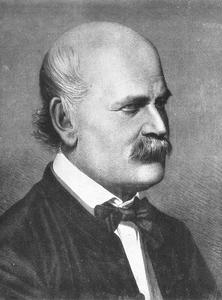These words were spoken to me by the late Dr James Cyriax. He was lamenting the fact that he didn’t get the recognition he felt he deserved for his seminal work in diagnosing and treating the ubiquitous disorders of back pain, sciatica, shoulder pain, etc. Even after his death in 1985 his work has been largely ignored.
A similar, though much worse, fate attended Dr Ignaz Semmelweis (pictured). He was a nineteenth century Hungarian physician who, in the days before the discovery of bacteria, by careful observation realised how to prevent childbirth fever – a serious and often fatal infection of women who had just given birth. He insisted on hand washing by doctors emerging from the post-mortem room before they went to the delivery ward in the hospital where he worked. Incredible as it now seems, this life-saving admonition conflicted with established medical views of the time and incurred the great displeasure of his colleagues. He was committed to a mental asylum where he died. Nonetheless, Semmelweis was known as the Saviour of Women.
While I in no way compare my small contribution to the achievements of these great men, I feel I am similarly being ignored by the mainstream medical profession in the matter of smoking cessation.
As I have written in various postings, the orthodox approach to quitting smoking goes something like this:
• Remember that quitting smoking is going to be very hard
• Pick a ‘quit date’
• Prepare to quit by making a list of your reasons for quitting, announcing your intention to your family and friends
• Watch out for your ‘triggers’ to smoke and plan how you will deal with them
• Stock up on quitting ‘aids’ such as nicotine gum or patches
• If these don’t work, see your doctor for prescription stop-smoking drugs
• If necessary, use nicotine products and prescription drugs
• Attend your friendly local stop-smoking clinic for on-going support.
• To deal with your cravings and urges to smoke, distract yourself, drink plenty of water or eat healthy snacks
• If (when?) you fail, don’t worry. Failing to quit doesn’t mean you’ve failed – you just have to keep trying (that is, failing) a bit longer!
• If none of the above work, consider using e-cigarettes as an alternative to smoking even though you’ll continue to be addicted to nicotine, possibly for life
Gentle reader, the above is not cynicism: it’s literally what stop smoking services will tell you.
The Symonds Method, on the other hand, works like this:
• Remember that quitting smoking can be easy if you go about it the right way
• As a smoker, your need is to quit is right now
• You are well aware of your reasons for wanting to quit: a) health, b) money
• Do not use nicotine products including e-cigarettes, or drugs
• The idea of cravings and urges to smoke is greatly exaggerated and largely untrue
• With the right understanding and support you’ll be able to enjoy the rest of your life as a non-smoker
• You won’t need to worry about failing – because you won’t fail!
Now you can see why I’m not popular with my profession when it comes to curing people of smoking. I’m doing it the wrong way!
Text © Gabriel Symonds


Leave A Comment